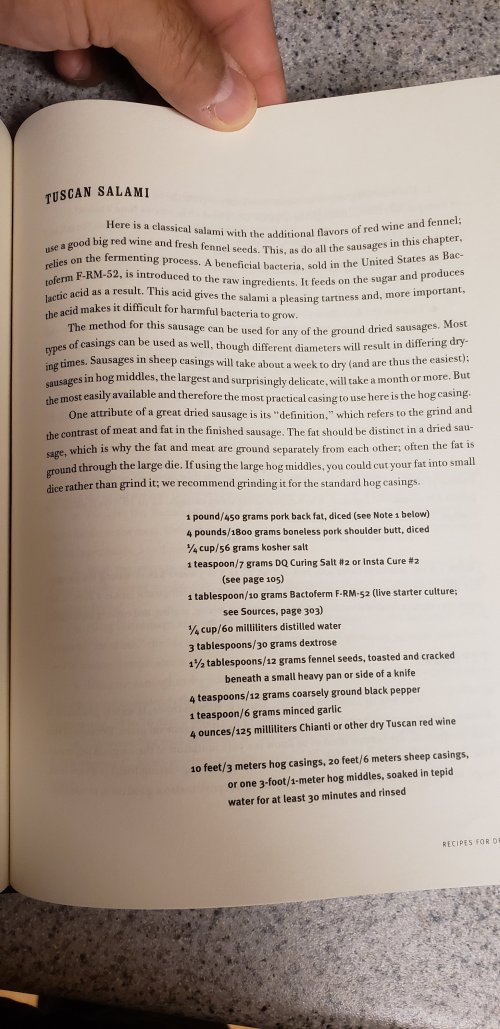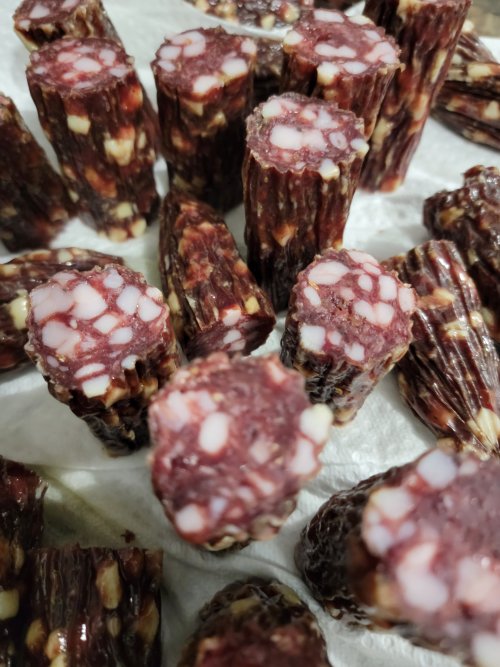Navigation
Install the app
How to install the app on iOS
Follow along with the video below to see how to install our site as a web app on your home screen.
Note: This feature may not be available in some browsers.
More options
You are using an out of date browser. It may not display this or other websites correctly.
You should upgrade or use an alternative browser.
You should upgrade or use an alternative browser.
2022 Salami
- Thread starter brocksw
- Start date
MarvB
Well-known member
Lookin good!
WildWill
Well-known member
Something I've always wanted to try but never have. Looks great!
Sask hunter
Well-known member
- Joined
- Sep 20, 2016
- Messages
- 2,971
Looks real good!!
Goodfish
Well-known member
Have beer. Will travel. Looks great!
Finished my batch of mule deer salami for the year. 10 lbs at the start and around 6.5 to 7 finished.
View attachment 215810
Details
Nick87
Well-known member
What he said, I've Got about half of one deer left enlighten me please.Details
rtraverdavis
Well-known member
Man that looks good. I too would love to hear the details.
brocksw
Well-known member
Recipe is below. There's a second page not shown, but this should cover ingredients.
Recipe comes from the Bible, Mark Ruhlman's Charcuterie book. I'd highly recommend this book. This is the Tuscan Salami recipe which from what I can tell is basically a fennel salami recipe.
I use UMAI dry 50mm tubes instead of more traditional materials. It's just easier to work with and imo makes this really fool proof.

I get Bactoferm F-RM-52 from sausage maker as well.

 www.sausagemaker.com
www.sausagemaker.com
I usually only make this in the winter because I can keep my garage about 60 degrees and hang about 10 tubes in a card board box. It gets a little dry in my garage so my batches usually develop a harder outside layer than what's typically desired. If you have a vacant refrigerator that you can control humidity in, that would work too, but might take longer unless you have a way to circulate air. Target conditions for drying are 50-60 degrees and 50-85% humidity, depending on who you listen to. Most years, I get my conditions to be around 60 degrees and 20% humidity.
I modify the recipe a bit because I'm using wild game. But for a single batch I usually go for 2-2.5lbs of ground deer or pronghorn, 1.5-2 lbs of ground pork, and then I get 1 pound of good pork back fat and dice that up into tiny cubes. Mix and stuff into the umai 50mm tubes, then weigh. I label each tube so I know what starting weight was. Leave the tubes to hang in the house for 2 or 3 days to start fermentation, then transfer to the garage. I usually make double batches, so double everything above.
It's important to use the correct cure and bacteria. This recipe calls for instacure #2 (which I also order from the sausagemaker website), that is a slow release cure that has nitrates and nitrites in it. That's what we want since this meat will be dry curing with no heat.
I typically leave mine hang for 4-5 weeks on average but this batch went a full 8 weeks. Just depends on conditions. Each tube should lose a minimum of 30% of it's weight. If there is any white mold that grows on the outside I don't worry about it and just wipe it off when it's done. Make sure to stuff tightly so there is no air pockets inside the meat. Those air pockets will get moldy and go bad. Other than that, I just look for any weird discoloration or funny smells, I've never found any but I've been told that's about the best indicator of something going wrong.
I've made this recipe a few years in a row now with great success. It was a bit intimidating at first but it's super easy now. It's pretty hard to mess up if you can prevent your curing area from getting too warm. Next step is to make a curing box that allows me to make this year round.

Recipe comes from the Bible, Mark Ruhlman's Charcuterie book. I'd highly recommend this book. This is the Tuscan Salami recipe which from what I can tell is basically a fennel salami recipe.
Charcuterie: The Craft of Salting, Smoking, and Curing: Ruhlman, Michael, Polcyn, Brian, Solovyev, Yevgenity: 8601404327117: Amazon.com: Books
Charcuterie: The Craft of Salting, Smoking, and Curing [Ruhlman, Michael, Polcyn, Brian, Solovyev, Yevgenity] on Amazon.com. *FREE* shipping on qualifying offers. Charcuterie: The Craft of Salting, Smoking, and Curing
www.amazon.com
I use UMAI dry 50mm tubes instead of more traditional materials. It's just easier to work with and imo makes this really fool proof.

UMAi Dry 50mm Sausage Casing Packet
Use the UMAi Dry 50mm Sausage Casing Packet to effortlessly make mouth-watering pepperoni, salami, chorizo, and more. We sell local foods, spices and centuries-old traditional production techniques for at home sausage & food processing.
www.sausagemaker.com
I get Bactoferm F-RM-52 from sausage maker as well.

Bactoferm F-RM-52
Bactoferm F-RM-52 is a meat starter culture for the production of fast fermented meat products at temperatures between 72-90°F. Ideal for German Mettwurst.
I usually only make this in the winter because I can keep my garage about 60 degrees and hang about 10 tubes in a card board box. It gets a little dry in my garage so my batches usually develop a harder outside layer than what's typically desired. If you have a vacant refrigerator that you can control humidity in, that would work too, but might take longer unless you have a way to circulate air. Target conditions for drying are 50-60 degrees and 50-85% humidity, depending on who you listen to. Most years, I get my conditions to be around 60 degrees and 20% humidity.
I modify the recipe a bit because I'm using wild game. But for a single batch I usually go for 2-2.5lbs of ground deer or pronghorn, 1.5-2 lbs of ground pork, and then I get 1 pound of good pork back fat and dice that up into tiny cubes. Mix and stuff into the umai 50mm tubes, then weigh. I label each tube so I know what starting weight was. Leave the tubes to hang in the house for 2 or 3 days to start fermentation, then transfer to the garage. I usually make double batches, so double everything above.
It's important to use the correct cure and bacteria. This recipe calls for instacure #2 (which I also order from the sausagemaker website), that is a slow release cure that has nitrates and nitrites in it. That's what we want since this meat will be dry curing with no heat.
I typically leave mine hang for 4-5 weeks on average but this batch went a full 8 weeks. Just depends on conditions. Each tube should lose a minimum of 30% of it's weight. If there is any white mold that grows on the outside I don't worry about it and just wipe it off when it's done. Make sure to stuff tightly so there is no air pockets inside the meat. Those air pockets will get moldy and go bad. Other than that, I just look for any weird discoloration or funny smells, I've never found any but I've been told that's about the best indicator of something going wrong.
I've made this recipe a few years in a row now with great success. It was a bit intimidating at first but it's super easy now. It's pretty hard to mess up if you can prevent your curing area from getting too warm. Next step is to make a curing box that allows me to make this year round.

Last edited:
Similar threads
- Replies
- 14
- Views
- 535
- Replies
- 20
- Views
- 1K
- Replies
- 17
- Views
- 1K





